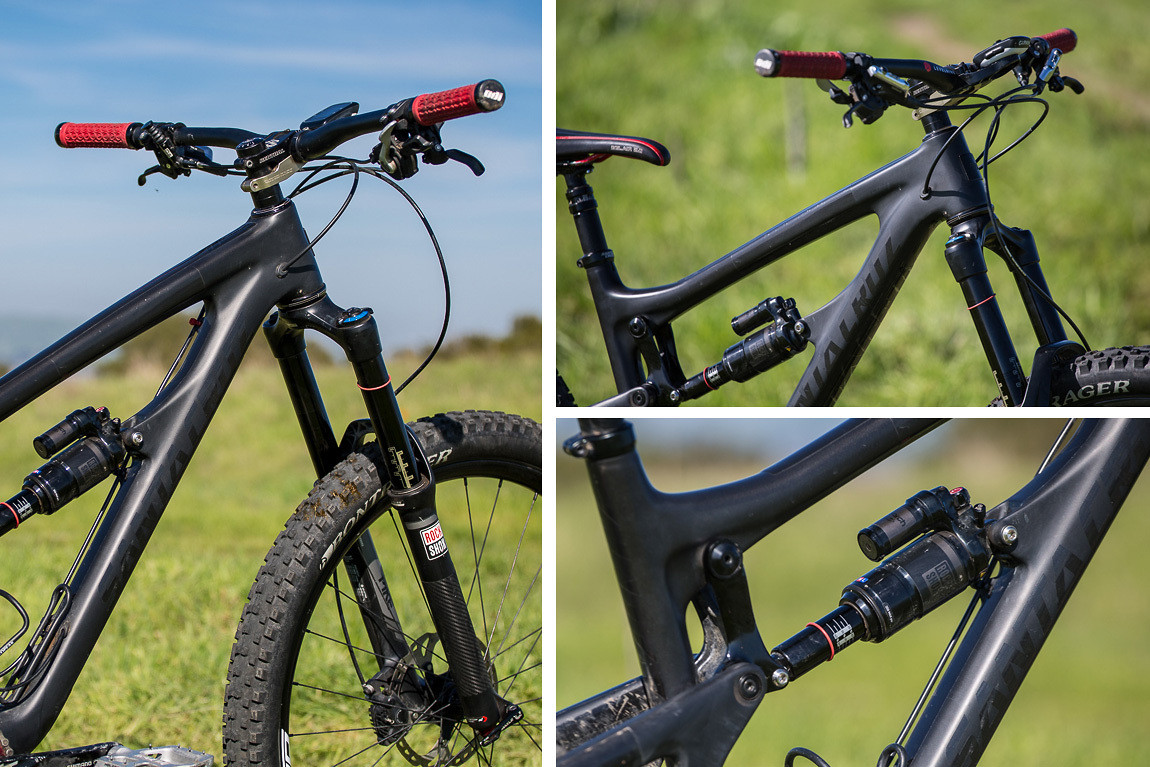
When rumors came that a follow up to the popular Nomad model was in development, the big question was, “where would they go from here?” 27.5 inch wheels were a no-brainer, but the Bronson already nailed it as their all mountain trail bike. That freed the Nomad up to have a more single minded personality— one specifically aimed at needs of racers tackling the Enduro World Series.

Splitting the travel (and geometry) difference between the Bronson and the DH specific V10, Santa Cruz created a purpose built machine intended for the European enduro circuit. To do well there, the bike would need the descending prowess of the V10, but maintain as much of the all mountain capability of the Bronson as possible for the numerous pedaling sections.
CONSTRUCTION
The Nomad is constructed with a full carbon frame and swing arm but uses forged alloy upper and lower links. In a shift from previous offerings, the Nomad features an internal cable routing for the rear derailleur and dropper posts. Bike mechanics everywhere can breathe a sigh of relief as Santa Cruz wisely left the rear brake line on the outside of the bike where it can be easily serviced, as well as bucking the trends and sticking with a threaded bottom bracket shell.

The down tube and drive side of the swing arm are protected from potential rock strikes by a molded rubber protector. The frame features Santa Cruz's collet axle pivots, which are easily adjusted should play develop. In order to get the chainstays as short as possible, Santa Cruz doesn’t provide provisions for a front derailleur, but with today’s wide range drivetrains, the gearing is more than adequate for the bike’s intended use.

HIGHLIGHTS
- Carbon CC frame
- 31.6mm seat post sizing allows a 6” internally routed dropper post
- 65º head angle
- 74.2º seat tube angle
- 16.5” seat tube length (on size medium frame)
- 433.1mm/ 17.05” chain stay length
- Threaded bottom bracket shell
ON THE TRAIL
We’ve ridden the previous model of the Nomad extensively, and the latest iteration of the Nomad reads like a list of all the upgrades and features we could have wished for: slacker head angle, steeper seat tube angle, longer reach, and shorter chain stays. Swinging a leg over the bike we felt instantly at home, and as more and more time was spent on the bike, we found ourselves pushing the limits of what we previously thought possible on a trail bike. We’ve taken the Nomad all over, on rides ranging from all mountain epics to flow trails, as well as full days at the Northstar and Big Bear bike parks.

The relaxed head tube angle makes the Nomad a joy to descend, and the bike shines the brightest when hitting the trail with momentum. The confidence it inspires allows riding lines normally reserved for downhill bikes. As we became more comfortable on the bike, we added first one, then a second volume spacer to the Pike as we started riding our familiar haunts and at progressively higher speeds. We had similar experiences at the bike park, as the relatively light weight let us flick the bike around and ride tighter trails at higher speeds than our downhill bikes.

The Nomad is designed to perform while descending, but the steep seat angle makes it surprisingly capable when pointing it back uphill. That said, the relaxed head angle which shines pointed down, does make slow speed technical moves more difficult. However, once we became accustomed to it, we were able to clean many challenging climbs with good technique and a bit of effort.
It pedals well too. Like the rest of the bikes with the VPP suspension design, the Nomad accelerates with a snappy feel and feels responsive to input on the pedals. In fact, although the Nomad was heavier than the Blur TRc we had been riding, the latest iteration of the VPP felt like it bobbed less under power, and with the Rockshock Monarch in climb mode it felt extremely efficient.
You won’t be winning any hill climbs, but if that’s your concern is, you’re looking at the wrong category of bike. Although it climbs extremely well for its intended use, on long, all day rides that $3k carbon wonder wheel set sounds more and more appealing.

Our test rig features a full XT group, and with the reliable Spank Ozzy trail wheelset with a retail price in the range of $6500. It’s a solid and reliable setup for aggressive riding, but after lifting a few sub-27lb. top end builds, we began to consider putting the bike on a diet, as it would take it to a whole new level as an aggressive trail bike while still descending like a mini-dh machine.
The Nomad is a solid representation of the new breed of bikes that can truly do it all, holding its own in a wide variety of terrain. If you're the type of rider that tolerates climbs and lives for long, technical descents, or are looking to consolidate a quiver of bikes (that includes a full blown DH rig) its a bike you’ll want to take a close look at.
*Thanks to Inga Beck and Izaak Van Horn for assistance with photography
0 comments
To post, please join, log in or connect to Vital using your Facebook profile Login with Facebook.





